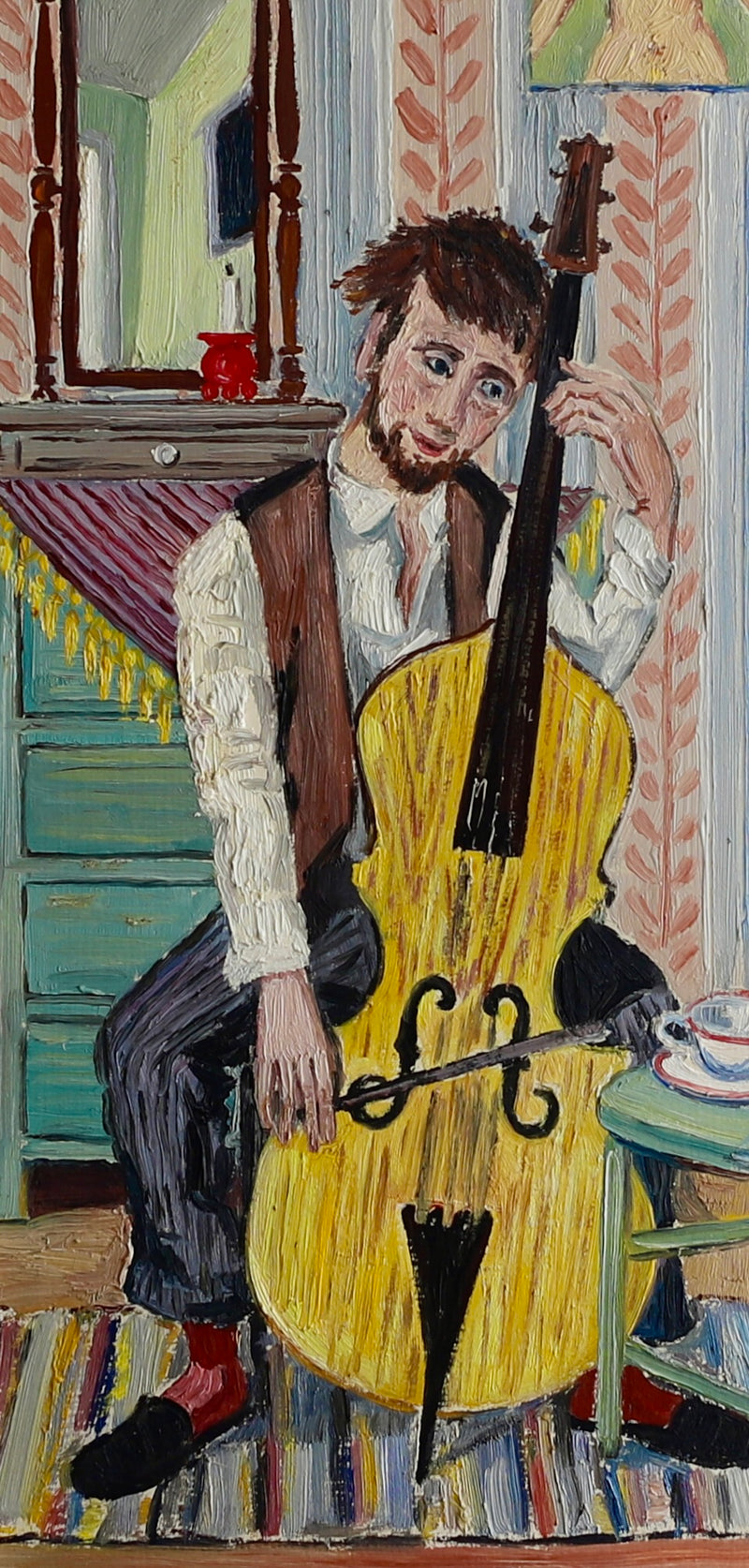The Role of Feeling and Expression in Metaphorical Oil Paint: A Comprehensive Analysis of Subject and Structure
The interaction of feeling and expression in figurative oil painting acts as a critical lens whereby one can take a look at the elaborate partnership between subject matter and composition. Artists harness different techniques, from shade selection to brushstroke dynamics, to grow emotional resonance within their jobs. This nuanced orchestration not just forms audience perception yet also invites a deeper query into just how these components integrate to reflect the intricacies of human experience. As we explore this abundant surface, one need to consider how details study illuminate the more comprehensive ramifications of these imaginative selections.
Comprehending Feeling in Art
Emotion in art works as a powerful avenue for expression, allowing musicians to communicate intricate feelings with their job. In metaphorical oil painting, this emotional depth is usually represented with the representation of the human figure, capturing the nuances of human experience. The option of subject matter, shade palette, and brushwork all add to the psychological resonance of a piece.
Artists frequently attract upon individual experiences, social issues, or universal styles to stimulate feelings in the visitor. For instance, a portrait might show vulnerability, while a vibrant figure in motion can symbolize freedom or chaos. These emotional strings connect the customer to the artwork, promoting a discussion that goes beyond the aesthetic medium.
Moreover, the interplay between light and shadow can magnify psychological strength, assisting the customer's stare and accentuating specific aspects within the structure. The use of structure in oil painting additionally adds layers of complexity, welcoming a responsive response that boosts the psychological experience. On the whole, comprehending feeling in art is essential for appreciating the nuances that define figurative oil paint, as it changes simple representation right into an extensive expedition of the human condition.
Crucial Element of Composition
In the world of metaphorical oil paint, the composition functions as the underlying framework that arranges aesthetic aspects and improves the psychological story. Crucial parts of structure include balance, contrast, prime focus, and rhythm, each contributing to the total impact of the art work.
Balance describes the circulation of aesthetic weight within the paint, which can be accomplished through unbalanced or in proportion arrangements. A healthy structure provides stability, enabling the customer to engage with the item harmoniously - figurative oil painting. Comparison, on the other hand, entails juxtaposing various aspects, such as dark and light or warm and awesome shades, to lead the visitor's eye and evoke psychological reactions
The focal factor is important, as it directs interest to the most significant part of the paint, frequently highlighting the psychological core of the story. By masterfully integrating these essential aspects, artists can craft engaging and emotionally powerful figurative oil paints that captivate and engage their audience.
Subject Matter and Its Impact
Topic plays an essential duty in figurative oil paint, as it not only acts as the foundation for the narrative but likewise shapes the viewer's analysis and emotional involvement with the artwork. The option of subject issue-- be it a singular figure, a group dynamic, or a thematic depiction-- directly influences the psychological atmosphere conveyed to the audience.

For example, pictures commonly stimulate individual connections, revealing the intricacies of human expression and character, while scenes depicting communal tasks can create a sense of belonging or fond memories. The cultural and historic context of the subject matter enriches the visitor's understanding, triggering much deeper representations on societal norms, values, and the human problem.
Various subject issues additionally create varying levels of involvement; a remarkable conflict depicted via numbers in stress may evoke feelings of anxiousness or empathy, while peaceful landscapes can conjure up harmony and reflection. Ultimately, the effect of topic in figurative oil paint is profound, as it acts as a conduit for psychological resonance, assisting the customer's action and analysis, and promoting a connection between the observer and the artwork. This interplay is essential for the effective interaction of the artist's intent.
Techniques for Stimulating Sensations
The performance of figurative oil painting in sharing emotions is considerably affected by the techniques utilized by the artist. One of the most essential methods is the use of shade concept, where the calculated choice of hues can evoke specific psychological feedbacks. Warm shades, such as oranges and reds, usually elicit sensations of enthusiasm or hostility, while cooler tones like blues and eco-friendlies often tend to evoke calmness or sadness.
An additional vital method is the control of light and darkness, referred to as chiaroscuro. This method boosts the three-dimensionality of numbers, creating remarkable contrasts that can magnify emotional depth. The placement of light can direct visitors' emotions, highlighting details elements of the structure.
Brushwork also plays a critical duty; loose, meaningful strokes can share energy and spontaneity, whereas smoother techniques might recommend harmony or precision. The plan of subjects within the composition can influence psychological influence. Close distance can suggest intimacy, while range may indicate seclusion.
Ultimately, the mix of these methods enables musicians to craft narratives that see it here reverberate with the Full Article customer, transforming a plain visual experience right into an expressive emotional trip. - figurative oil painting

Situation Studies of Significant Works
Taking a look at remarkable jobs of figurative oil paint discloses how different methods are utilized to evoke powerful feelings. One excellent instance is Edvard Munch's "The Scream," where the distorted figure and swirling background communicate existential fear. Munch's usage of shade-- vibrant oranges and deep blues-- magnifies the emotional effect, showcasing just how palette selections can shape customer experience.
One more significant job is Pablo Picasso's "Les Demoiselles d'Avignon." Here, fragmented kinds and bold brushstrokes show a turbulent psychological landscape, challenging typical representations of the women number. Picasso's ingenious composition not just catches the audience's interest however likewise welcomes consideration on motifs of identity and sexuality.
In Addition, Frida Kahlo's "Both Fridas" uses a touching exploration of duality and self-identity. The different numbers, connected by a shared heart, exemplify Kahlo's emotional deepness and individual story. figurative oil painting. Her precise attention to detail and symbolic components serve to engage visitors on a natural level
These study emphasize the extensive connection in between feeling and structure in figurative oil paint, exposing how musicians harness strategy to interact complex sensations and narratives that reverberate throughout time and culture.

Conclusion
Finally, the interaction of emotion and expression in metaphorical oil painting dramatically enhances the audience's experience and analysis of the art work. Via a mindful choice of topic and compositional methods, musicians convey profound stories that reverberate on both personal and global degrees. The application of color chiaroscuro, brushwork, and theory more enhances psychological depth, transforming each canvas into an effective representation of the complexities of the human experience.
In figurative oil a fantastic read painting, this psychological deepness is often portrayed with the representation of the human number, capturing the nuances of human experience.Additionally, the interplay in between light and darkness can amplify emotional intensity, assisting the visitor's stare and attracting attention to specific components within the composition. The use of structure in oil painting additionally includes layers of complexity, inviting a tactile action that improves the psychological experience.The focal factor is crucial, as it directs attention to the most considerable part of the painting, commonly highlighting the psychological core of the story. Eventually, the effect of subject matter in figurative oil paint is profound, as it serves as an avenue for emotional resonance, guiding the audience's reaction and interpretation, and promoting a link between the viewer and the artwork.